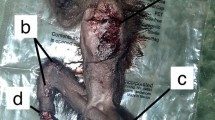Abstract
While male primates commonly use their large canine teeth in agonistic conflict and display, observations that females use their canines in intraspecific fighting are very rare. We report the death of a female Cercopithecus diana in the Taï Forest, Ivory Coast. She was killed by other females from a single troop. It is not clear whether the victim was a troop resident or was transferring from another group. The conflict was not a result of territorial defense or intergroup conflict. Autopsy of the specimen confirmed severe lacerations to the body, inflicted with canine teeth. This is the first published description of unambiguous use of canine teeth as weapons by free-ranging female forest-dwelling guenons. The incident demonstrates that female Cercopithecus species can engage in lethal intrasexual combat and that female C. diana can inflict serious wounds via their canines.
Similar content being viewed by others
REFERENCES
Cords, M. (1987). Forest guenons and patas monkeys: Male- male competition in one-male groups. In Smuts, B. B., Cheney, D. L., Seyfarth, R. M., Wrangham, R. W., Struhsaker, T.T. (eds.), Primate Societies, University of Chicago Press, Chicago, pp. 98–111.
Cords, M. (1988). Mating systems of forest guenons:Apreliminary review. In Gautier-Hion, A., Bourliere, F., Gautier, J., Kingdon, J. (eds.), A Primate Radiation, Cambridge University Press, Cambridge, pp. 323–339.
Cords, M. (2000a). The number of males in guenon groups. In Kappeler, P. M. (ed.), Primate Males, Cambridge University Press, Cambridge, pp. 84–96.
Cords, M. (2000b). Agonistic and affiliative relationships in a blue monkey group. InWhitehead, P. F., and Jolly, C. J. (eds.), Old World Monkeys, Cambridge University Press, Cambridge, pp. 453–479.
Drews, C. (1996). Contexts and patterns of injuries in free-ranging male baboons (Papio cynocephalus).Behavior 133: 443–474.
Greenfield, L. O. (1992a). Origin of the human canine: A new solution to an old enigma. Yrbk.Phys. Anthropol. 35: 153–185.
Greenfield, L.O. (1992b). Relative canine size, behavior and diet in male ceboids. J. Hum. Evol. 23: 469–480.
Greenfield, L.O. (1998). Canine tip wear in male and female anthropoids. Am. J. Phys. Anthropol 107: 87–96.
Gust, D. A., and Gordon, T. P. (1991). Female rank instability in newly formed groups of familiar Sooty Mangabeys (Cercocebus torquatus atys). Primates 32: 465–471.
Harvey, P. H., Kavanagh, M., and Clutton-Brock, T. (1978). Canine tooth size in female primates.Nature 276: 817–818.
Hill, C. M. (1994). The role of female diana monkeys, Cercopithecus diana, in territorial defense.Anim. Behav. 47: 425–431.
Isbell, L. A., and Pruetz, J. D. (1998). Differences between vervets (Cercopithecus aethiops) and patas monkeys (Erythrocebus patas) in agonistic interactions between adult females.Int. J. Primatol. 19: 837–855.
Isbell, L. A., and Van Vuren, D. (1996). Differential costs of locational and social dispersal and their consequences for female group-living primates. Behavior 133: 1–36.
Kaplan, J. R. (1987).Dominance and affiliation in Cercopithecini and Papionini:Acomparative examination. In Zucker, E. L. (ed.), Comparative Behavior of African Monkeys, Alan R.Liss, Inc., New York, pp. 127–150.
Kay, R. F., Plavcan, J. M., Glander, K. E., and Wright, P. C. (1988). Sexual selection and canine dimorphism in New World monkeys. Am. J. Phys. Anthropol. 77: 385–397.
Kuester, J., and Paul, A. (1992). Influence of male competition and female mate choice on male mating success in Barbary macaques (Macaca sylvanus). Behavior 120: 192–217.
Leutenegger, W., and Kelly, J. T. (1977). Relationship of sexual dimorphism in canine size and body size to social, behavioral, and ecological correlates in anthropoid primates. Primates 18: 117–136.
Packer, C., and Pussey, A. (1985). Asymmetric contests in social mammals: respect, manipulation and age-specific aspects. In Greenwood, P. J., Harvey, P. H., and Slatkin, M. (eds.), Evolution, Essays in Honour of John Maynard Smith, Cambridge University Press, Cambridge, pp. 173–186.
Plavcan, J. M. (1990). Sexual Dimorphism in the Dentition of Extant Anthropoid Primates, Phd Dissertation, University Microfilms, Ann Arbor, MI.
Plavcan, J. M. (1993). Canine size and shape in male anthropoid primates. Am. J. Phys. Anthropol. 92: 201–216.
Plavcan, J. M. (1998). Correlated response, competition, and female canine size in primates.Am. J. Phys. Anthropol. 107: 401–416.
Plavcan, J. M., and van Schaik, C. P. (1992). Intrasexual competition and canine dimorphism in anthropoid primates. Am. J. Phys. Anthropol. 87: 461–477.
Plavcan, J. M., and van Schaik, C. P. (1994). Canine dimorphism. Evol. Anthropol. 2: 208–214.
Plavcan, J. M., van Schaik, C. P., and Kappeler, P.M. (1995). Competition, coalitions and canine size in primates. J. Hum. Evol. 28: 245–276.
Pruetz, J. D., and Isbell, L. A. (2000). Correlations of food distribution and patch size with agonistic interactions in female vervets (Chlorocebus aethiops) and patas monkeys (Erythrocebus patas) living in simple habitats. Behav. Ecol. Sociobiol. 49: 38–47.
Rowell, T. E. (1972). Organization of caged groups of Cercopithecus monkeys. Anim. Behav. 19: 625–645.
Smith, R. J. (1981). Interspecific scaling of maxillary canine size and shape in female primates: Relationships to social structure and diet. J. Hum. Evol. 10: 165–173.
Smuts, B. B. (1987). Gender, aggression, and influence. In Smuts, B. B., Cheney, D. L., Seyfarth, R. M., Wrangham, R. W., and Struhsaker, T. T. (eds.), Primate Societies, University of Chicago Press, Chicago, pp. 400–412.
Sterck, E. H. M. (1995). Females, Foods and Fights; A Socioecological Comparison of the Sympatric Thomas Langur and Long-Tailed Macaque Phd dissertation, University of Utrecht.
Struhsaker, T.T. (2000).Variation in adult sex ratios of red colobus monkey social groups: Implications for interspecific comparisons. In Kappeler, P. M., (ed.) Primate Males, Cambridge University Press, Cambridge, pp. 108–119.
Zuberbuhler, K. (2000a). Causal knowledge of predators' behavior in wild Diana monkeys.Anim. Behav. 59: 209–220.
Zuberbuhler, K. (2000b). Referential labeling in Diana monkeys. Anim. Behav. 59: 917–927.
Author information
Authors and Affiliations
Rights and permissions
About this article
Cite this article
McGraw, W.S., Plavcan, J.M. & Adachi-Kanazawa, K. Adult Female Cercopithecus diana Employ Canine Teeth to Kill Another Adult Female C. diana . International Journal of Primatology 23, 1301–1308 (2002). https://doi.org/10.1023/A:1021131021662
Issue Date:
DOI: https://doi.org/10.1023/A:1021131021662



